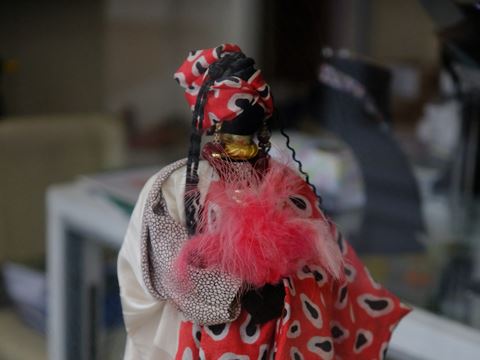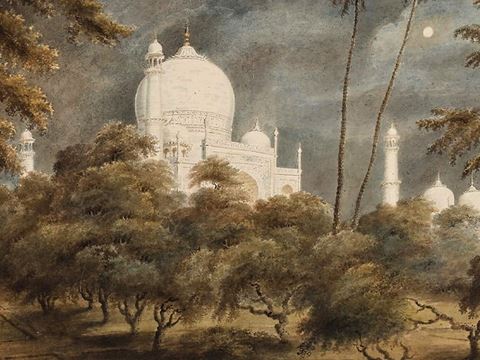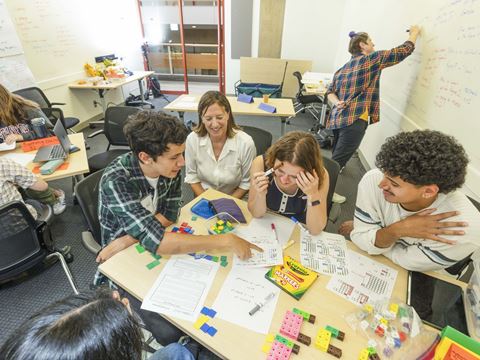.jpg?cx=0.31&cy=0.53)
Building Bridges in the Classroom: The Stari Most Story for Teaching Writing and Cultural History
For the Teacher's Desk
Written by Lauren Barack
Built environments can foster community within cities and neighborhoods and change how we view the world.
As a young architect in 2000, Aida Idrizbegović-Zgonić climbed Mostar’s cobbled streets and stopped mid-step. Ahead of her, what remained of Stari Most—the “Old Bridge”—swallowed sunlight and threw it back as glare. For centuries, its spine had absorbed the slap of wet laundry beating against the stone, muffled the arguments of coppersmiths in the market and flexed under the weight of teenage boys daring one another to dive. It didn’t just cross the Neretva River. It metabolized the city.
Then in 1993, the explosions came. When the stone arch crumpled into the water, the market stalls went quiet mid haggle.
“The inhabitants and citizens felt this tremendous loss of the bridge,” says Idrizbegović-Zgonić, a professor of theory and history of architecture at the University of Sarajevo. “They were actively mourning the bridge.”
In AramcoWorld’s story “The Bridge of Meanings,” writer Ian Bancroft walks readers through the monument’s resurrection—not just as a structure but as a symbol. To the people of Mostar, a city of just over 100,000 people where Bosnians, Croats and Serbs intersect, Stari Most represents more than an arch of limestone. It is a guardian, a storyteller, a silent witness to history.

"For some, the bridge is a person. For some it's a friend. For some, it's a family member."
“For some,” says Bancroft, a former diplomat and author of the novel Luka, “the bridge is a person. For some it’s a friend. For some, it’s a family member.”
Now, AramcoWorld’s latest Learning Center lesson helps bring this living monument into the classroom. Through Bancroft’s story, students explore metaphor, cultural memory and the power of place—while aligning with Common Core Standards for critical analysis.
The learning doesn’t stop in Mostar. Teachers can guide students to uncover the “bridges” in their own cities: the parks, markets and landmarks that stitch communities together. Because some structures don’t just stand—they speak.
Metaphor as a Writing Tool for Explaining History of Old Bridge Mostar
The physical bridge, built in 1566 by the 10th Ottoman sultan, Suleiman the Magnificent, had always served as more than a river crossing. That is why, when the bridge fell in 1993, the destruction rippled far beyond its physical absence. What had stood for centuries as both an architectural marvel a and social touchtone suddenly existed only in memory and fragments. Its absence revealed its true significance.
“It’s not just a functional thing that helps you get from A to B,” says Bancroft. “It’s something that creates connections or possibilities.”
The reconstruction effort became about more than restoring stonework. This distinction between utility and symbolism forms the lesson’s foundation. Students learn to identify how the text gradually layers meaning onto the bridge, moving from literal description to allegorical significance.

"What's the thing you want your audience to be able to visualize or make a heart connection to? ... Then pull that out."
The curriculum provides specific pathways for this analysis: noting where concrete details begin representing abstract ideas; mapping how the re-formation narrative mirrors Bosnia’s social healing; practicing this technique by identifying physical connectors where people live.
“A bridge is such a powerful symbol,” says Idrizbegović-Zgonić.
Teachers extend this insight by having students examine how symbols function in their own lives. The National Writing Project’s Executive Director Tanya Baker advises educators approach the topic when teaching metaphors.
“What's the thing you want your audience to be able to visualize or make a heart connection to,” she says. “Then pull that out.”
Metaphor as Visual Analysis
As a physical structure, the “Old Bridge” offers rich opportunities to explore meaning and allegories through visual metaphors. In Learning Center lessons, pupils analyze the article’s central theme while employing techniques similar to those that photographer Armin Durgut adopts.
“If a bridge is more than just a structure, if it’s a lifeline, a symbol of resilience and a witness to history, then my goal is to translate that into images,” says Durgut, a photojournalist who works with the Associated Press, Pixsell and other news organizations. “I focused on textures, angles and light to emphasize its enduring presence while also capturing how people interact with it.”
The photographs and captions in the reading reveal the essence of the story. While most students may not visit Mostar during a class period, the details Durgut captured—from the gleaming handrails on the bridge to shadows across the sky—convey more than just the physicality of the span but the deep connections locals have with it.
“I want them to feel the weight of history, the layers of emotion attached to the space and the everyday life that continues around it,” he says. "My goal is to create an emotional response, to make viewers think about their own connections to places and history.”
Through cross-curricular opportunities, classes can apply this approach to other topics and then craft visual thematic reporting to paint a story tied to a social studies topic or a personal tale closer to home, for example. Durgut encourages students to first spend time without their camera or sketchbook to observe what they hope to capture.

"Start by researching. Talk to people, listen to their stories and understand why a place holds meaning."
“Start by researching. Talk to people, listen to their stories and understand why a place holds meaning,” he says. “Then, spend time there without the camera. See how light moves, how people interact, what details stand out.”
Stari Most, of course, served as more than just a passageway across the river. The “Old Bridge” is, as Durgut says, a place. That transformation of a space to a place is what Senada Demirović, a city adviser for urban planning in Mostar, says architecture and urban planning strive to accomplish. She says a place is "where we feel secure because our friends are there, our family is there. We are attached by some good memories.”
Demirović, like Idrizbegović-Zgonić, worked on the span’s restoration as a young architect. She says rebuilding the historical monument did not stitch the community together immediately, perhaps because the process happened so soon after the war. But to her, the ending of this story remains unwritten.
"People did cherish the moment of the bridge construction because it was the sign of hope,” she says. “They do understand the meaning of the bridge, as identity, as a part of Mostar’s history and a very important part of its future."
Other lessons

The Hill Rice Connection: Trace Its African Diaspora Roots and Examine How Communities Sustain Its Heritage
History
Geography
Anthropology
West Africa
Americas
Explore the connections between rice and African American agricultural history and analyze how hill rice connects to African American agricultural history and examine the Gullah Geechee community’s efforts to preserve this heritage through cultivation and storytelling.
The Impact of the Taj Mahal: Analyzing Changed Perceptions
Architecture
Art
History
South Asia
Analyze how 18th-century depictions of the Taj Mahal began changing Western European opinion of India.
How To Improve Student Confidence Through Seeing Math Differently
For the Teacher's Desk
Hands-on activities shift math from memorization to exploration—building confidence and curiosity in the classroom.